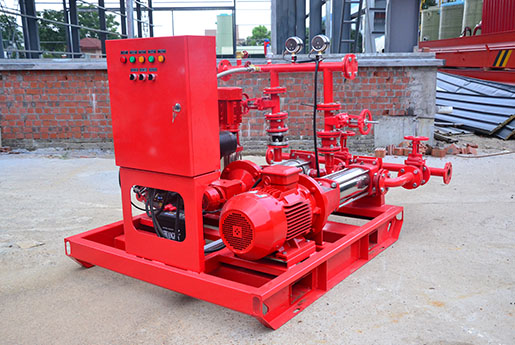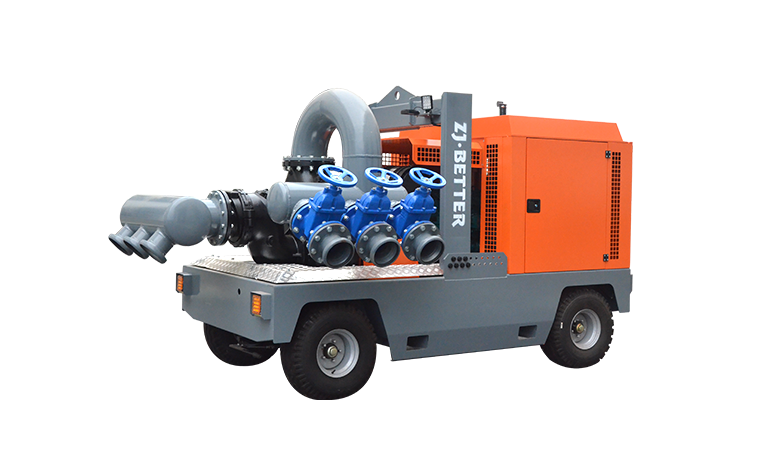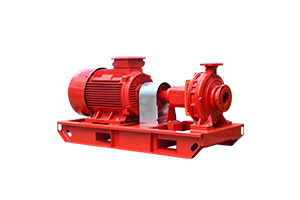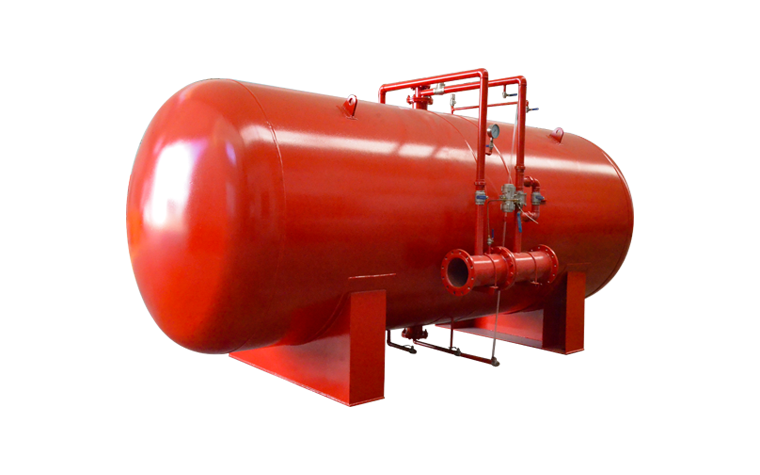-
 Jul 20, 2023Fire pump valve selection stepsSelecting the right fire pump valve is essential to ensure the effective operation of a fire protection system. Here are the steps you can follow to make the appropriate selection:
Jul 20, 2023Fire pump valve selection stepsSelecting the right fire pump valve is essential to ensure the effective operation of a fire protection system. Here are the steps you can follow to make the appropriate selection:
Determine system requirements: Understand the specific requirements of your fire protection system, including flow rate, pressure, and type of fire suppression system (e.g., sprinkler system, foam system).
Identify applicable standards and codes: Check local building codes, NFPA (National Fire Protection Association) standards, and any other relevant regulations to ensure compliance with safety and performance requirements.
Valve type selection: Based on the system requirements and applicable standards, choose the appropriate type of valve for your fire pump. Common types include:
a. Gate valves: These are typically used for on/off control and are often used as isolation valves to block water flow to specific sections of the system.
b. Butterfly valves: These provide efficient control over flow rates and are often used for modulating water flow.
c. Check valves: These valves allow water to flow in one direction only, preventing backflow and ensuring that water does not return to the pump.
d. Pressure relief valves: Used to protect the system from excessive pressure, ensuring the safety of both the pump and the connected components.
Material selection: Consider the materials used in the valve's construction, making sure they are compatible with the type of fire suppression system being used and can withstand the environment in which they will be installed (e.g., corrosive environments).
Size calculation: Determine the appropriate valve size based on the flow rate and pressure requirements of the fire protection system. Undersized valves may lead to inadequate water supply during firefighting, while oversized valves can be costly and inefficient.
Flow characteristics: Evaluate the flow characteristics of the valve, such as flow coefficient (Cv), pressure drop, and head loss. These factors can impact the overall performance of the fire protection system.
Actuation method: Decide on the valve actuation method, which can be manual, electric, pneumatic, or hydraulic. Consider the reliability and ease of operation for the selected method.
Manufacturer reputation and product quality: Research and choose a reputable valve manufacturer known for producing high-quality products and providing good customer support.
Installation and maintenance requirements: Ensure that the chosen valve is easy to install and maintain, and that spare parts are readily available when needed.
Consult with experts: If you are unsure about the selection process or have specific requirements, consider consulting with fire protection system designers, engineers, or valve experts to get professional advice.
By following these steps, you can select the most suitable fire pump valve for your fire protection system, ensuring optimal performance and compliance with safety standards.
View details -
 Jul 19, 2023Advantages of ordinary centrifugal pump automatic water supply deviceAn automatic water supply device using an ordinary centrifugal pump offers several advantages, making it a popular choice for various water supply applications. Some of the key advantages include:
Jul 19, 2023Advantages of ordinary centrifugal pump automatic water supply deviceAn automatic water supply device using an ordinary centrifugal pump offers several advantages, making it a popular choice for various water supply applications. Some of the key advantages include:
Continuous Water Supply: The automatic device ensures a continuous water supply without the need for manual intervention. It can detect when water levels drop below a certain point and activate the pump to replenish the water automatically.
Convenience: With an automatic water supply device, users don't have to manually start or stop the pump when the water level changes. This convenience is particularly beneficial in situations where a constant water supply is essential, such as in residential water systems or agricultural irrigation.
Energy Efficiency: Many automatic water supply devices are designed to be energy-efficient. They use sensors or switches to turn the pump on and off as needed, preventing unnecessary energy consumption when there is no demand for water.
Protection against Dry Running: Automatic devices often include dry run protection mechanisms. If the water source runs dry or if there's an issue with the pump, the device can shut off the pump to prevent damage from dry running, extending the pump's lifespan.
Pressure Regulation: Some automatic water supply devices incorporate pressure sensors or controllers to maintain consistent water pressure in the system. This feature is useful for applications requiring stable water pressure, such as in residential water distribution.
Space-saving: Integrating an automatic water supply device with a centrifugal pump eliminates the need for additional control equipment, resulting in a more compact and space-saving solution.
Reduced Water Wastage: By automatically monitoring water levels and usage, the device can optimize water supply and reduce wastage. This is especially important in applications where water resources are limited or expensive.
Remote Monitoring and Control: Some advanced automatic water supply devices can be integrated with smart systems, allowing remote monitoring and control through mobile applications or web interfaces. This feature provides users with real-time updates and control over their water supply system from anywhere.
Versatility: Automatic water supply devices can be used in various settings, such as homes, commercial buildings, farms, and industrial facilities. They are adaptable and can cater to different water supply requirements.
Reliability: When appropriately installed and maintained, automatic water supply devices with centrifugal pumps are reliable and can ensure a steady water supply for extended periods.
Overall, the automatic water supply device with an ordinary centrifugal pump offers convenience, energy efficiency, and protection against pump-related issues, making it a practical and reliable solution for water supply needs in various applications.
View details -
 Jul 19, 2023Causes of fire pump seal failureFire pump seal failure can have several causes, and it's crucial to address them promptly to ensure the pump's proper functioning and safety. Some of the common causes of fire pump seal failure include:
Jul 19, 2023Causes of fire pump seal failureFire pump seal failure can have several causes, and it's crucial to address them promptly to ensure the pump's proper functioning and safety. Some of the common causes of fire pump seal failure include:
Age and wear: Like any mechanical component, fire pump seals have a limited lifespan. Over time, they can become worn, brittle, and less effective at maintaining a proper seal, leading to failure.
Improper installation: Incorrect installation of the seal can lead to misalignment, excessive stress, or inadequate sealing. This may result in premature failure or reduced performance.
Contaminants: The presence of debris, dirt, or foreign particles in the pump's operating environment can damage the seal and cause it to fail prematurely.
Overheating: Fire pumps can generate significant heat during operation, and if the seal is not adequately designed to handle high temperatures or is subjected to thermal overload, it may fail.
Pressure fluctuations: Frequent pressure variations can put stress on the seal, causing it to degrade and ultimately fail.
Corrosion and chemical exposure: If the fire pump is exposed to corrosive chemicals or environments, the seal materials can deteriorate, leading to failure.
Shaft misalignment: Misalignment of the pump shaft can cause excessive wear on the seal, leading to leaks and failure.
Vibration and mechanical stress: Excessive vibration or mechanical stress on the pump can cause wear and tear on the seal, accelerating its failure.
Lack of maintenance: Insufficient or irregular maintenance of the fire pump can result in neglect of the seal's condition, leading to issues that may cause failure over time.
Material selection: Using incorrect or incompatible materials for the seal construction can lead to premature failure, especially if they cannot withstand the specific operating conditions.
Running dry: If the fire pump runs dry without adequate lubrication, the seal faces can overheat and wear out quickly.
To prevent fire pump seal failure, regular inspection, proper maintenance, and addressing any issues promptly are essential. Additionally, using high-quality seals designed for the specific application and operating conditions can significantly improve their longevity and performance.View details -
 Jul 18, 2023What should I do if the fire pump motor is overloaded and overheated?If the fire pump motor is overloaded and overheated, it's essential to take immediate action to prevent further damage and ensure the safety of the system. Here's what you should do:
Jul 18, 2023What should I do if the fire pump motor is overloaded and overheated?If the fire pump motor is overloaded and overheated, it's essential to take immediate action to prevent further damage and ensure the safety of the system. Here's what you should do:
Shut Down the Motor: As soon as you notice the motor is overloaded and overheated, shut it down immediately. This will prevent further damage to the motor and associated components.
Turn Off the Power: After shutting down the motor, turn off the power supply to the fire pump. This step ensures that no electrical current is flowing through the motor, reducing the risk of electrical hazards.
Allow Cooling Time: Let the motor cool down before attempting any further actions. Overheating can damage the motor's windings and insulation, so it's crucial to give it sufficient time to cool.
Check for Causes of Overload: Before attempting to restart the motor, identify the reasons for the overload. Common causes of motor overload include high amp draw, excessive mechanical load, voltage irregularities, or an issue with the pump impeller.
Inspect Motor and Components: Once the motor has cooled down, visually inspect it and the surrounding components for any signs of damage, loose connections, or blockages that might be causing the overload.
Clear Ventilation Path: Ensure that the motor and its ventilation system are free from obstructions that could impede proper cooling. Adequate ventilation is crucial for the motor's optimal performance.
Check Pump Impeller: If the motor is not the root cause of the overload, inspect the pump impeller for any clogs or obstructions that could be hindering the pump's operation. A blocked impeller can cause the motor to work harder and overheat.
Verify Voltage and Electrical Supply: Check the voltage and electrical supply to the motor to ensure it is within the specified operating range. Voltage irregularities can lead to motor overload.
Reduce Load: If possible, reduce the load on the motor by adjusting the fire pump system's operating conditions or controlling the water flow rate.
Address Mechanical Issues: If there are any mechanical issues with the fire pump system, such as misalignment or damaged bearings, address them promptly to prevent recurrent overloads.
Consult a Professional: If you are unsure about diagnosing or fixing the issue, it's best to contact a qualified fire pump technician or an electrician with experience in motor troubleshooting and repair.
Preventive Measures: Implement preventive measures to avoid future overloads and overheating. Regular maintenance and monitoring of the fire pump system can help detect and address potential issues before they escalate.
Remember, the fire pump is a critical component of fire protection systems, so it's essential to address any issues promptly and ensure the system's proper functioning in emergencies.
View details -
 Jul 18, 2023How to solve the failure of fire pump safety valve?The safety valve on a fire pump is a critical component that protects the system from overpressure. If the safety valve fails, it can lead to potentially dangerous situations. Here are steps to solve the failure of a fire pump safety valve:
Jul 18, 2023How to solve the failure of fire pump safety valve?The safety valve on a fire pump is a critical component that protects the system from overpressure. If the safety valve fails, it can lead to potentially dangerous situations. Here are steps to solve the failure of a fire pump safety valve:
Isolate the System: If you notice any issues with the safety valve, immediately isolate the fire pump system by shutting it down. This will prevent further damage and ensure the safety of personnel and the surrounding area.
Inspect the Valve: Carefully inspect the safety valve to identify any visible signs of damage, wear, or malfunction. Look for leaks, cracks, or any abnormalities that might be causing the failure.
Clean the Valve: In some cases, the safety valve might fail due to debris or dirt obstructing its operation. Clean the valve thoroughly, removing any contaminants that might be affecting its performance.
Check the Pressure Setting: Verify that the safety valve's pressure setting is correct. It should be calibrated to release excess pressure at the designated level to prevent overpressure in the system.
Check for Proper Installation: Ensure that the safety valve is installed correctly and that all connections are secure. Improper installation can lead to leaks and failures.
Replace Faulty Components: If you identify any damaged or worn-out parts within the safety valve, replace them with new, compatible components. It's essential to use manufacturer-approved parts to maintain the valve's integrity.
Perform System Tests: After resolving the issues with the safety valve, conduct comprehensive tests on the fire pump system to ensure that the valve functions correctly under various operating conditions.
Consider Professional Inspection: If you are unsure about diagnosing or fixing the safety valve issue, consider contacting a qualified fire pump technician or a certified professional to inspect and repair the valve. They will have the expertise to identify and address the problem effectively.
Implement Regular Maintenance: To prevent future failures, establish a regular maintenance schedule for the fire pump system, including routine checks of the safety valve. Regular maintenance helps to identify potential issues before they escalate into significant problems.
Follow Manufacturer Guidelines: Always follow the manufacturer's guidelines for installation, operation, and maintenance of the fire pump and safety valve. These guidelines are designed to ensure the proper functioning and safety of the equipment.
Remember, a malfunctioning safety valve compromises the reliability of the fire pump system, so prompt action and proper resolution are essential to maintain the pump's effectiveness in emergency situations.
View details -
 Jul 17, 2023Basic composition of fire pump knife gate valve and pneumatic actuatorA fire pump knife gate valve with a pneumatic actuator consists of two main components: the knife gate valve itself and the pneumatic actuator that controls the valve's opening and closing. Let's look at the basic composition of each component:
Jul 17, 2023Basic composition of fire pump knife gate valve and pneumatic actuatorA fire pump knife gate valve with a pneumatic actuator consists of two main components: the knife gate valve itself and the pneumatic actuator that controls the valve's opening and closing. Let's look at the basic composition of each component:
1. Knife Gate Valve:
The knife gate valve is a specific type of valve designed to provide a tight shut-off in applications where a free-flowing, unobstructed passage is not required. It is commonly used in systems where on/off control or isolation of the flow is necessary, such as fire protection systems. The basic composition of a knife gate valve includes:
Valve Body: The main casing of the valve that houses the gate and provides the flow path. The body is typically made of cast iron, stainless steel, or other materials suitable for the application.
Gate: The gate is a flat or beveled plate that moves in and out of the flow path to control the water flow. It is the primary component responsible for opening and closing the valve.
Seat: The seat is a soft or resilient material lining the valve body, which helps create a tight seal when the gate is closed. The seat prevents water leakage when the valve is shut.
Stem: The stem is a rod or shaft that connects the gate to the actuator. It transmits the actuator's movement to the gate, enabling the valve to open and close.
2. Pneumatic Actuator:
The pneumatic actuator is a device responsible for controlling the movement of the gate in the knife gate valve using compressed air. It converts the energy of the compressed air into mechanical motion to open or close the valve. The basic composition of a pneumatic actuator includes:
Actuator Housing: The outer casing of the actuator, which encloses and protects the internal components. It is usually made of metal or other durable materials.
Diaphragm or Piston: The diaphragm or piston is a flexible element inside the actuator that moves in response to changes in air pressure. When air is supplied, the diaphragm or piston moves, transferring the force to the gate and causing it to open or close.
Spring: The spring provides a closing force in the actuator. When air pressure is reduced, the spring pushes the diaphragm or piston back to its original position, closing the valve.
Air Inlet/Outlet Ports: These are the connections through which compressed air is supplied to and released from the actuator. The air inlet port controls the actuator's movement, while the outlet port vents the air to release pressure.
Position Control Mechanism: The actuator may have a mechanism to control the valve's position within the flow path. This allows for partial opening or throttling of the valve for flow control.
Emergency Shutdown Features: Pneumatic actuators may include fail-safe features to allow manual operation or automatic closing of the valve in case of emergencies or power failure.
Overall, the combination of a knife gate valve and a pneumatic actuator provides an efficient and reliable solution for controlling water flow in fire protection systems, ensuring quick response times and accurate flow control during firefighting operations.
View details

.png)
.png)

.png)


